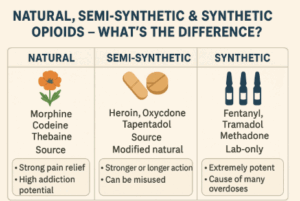Natural, Semi-Synthetic & Synthetic Opioids – What’s the Difference?
From the Poppy to the Lab – Know What You’re Dealing With
👀 Why This Matters
Understanding where opioids come from isn’t just academic—it’s critical for patients, caregivers, and policymakers. The source and structure of an opioid influence:
-
How addictive it is
-
How fast it acts
-
How it’s used or misused
-
How it’s detected and treated in overdose

🌿 1. Natural Opioids – Direct from the Poppy
Examples:
-
Morphine
-
Codeine
-
Thebaine
These are derived directly from the opium poppy (Papaver somniferum). They are the base compounds from which many other opioids are made.
🧬 Key Features:
-
Strong pain relief
-
High addiction potential
-
Morphine is the standard against which all other opioids are measured
🧪 2. Semi-Synthetic Opioids – Chemically Modified Naturals
Examples:
-
Heroin (diacetylmorphine)
-
Oxycodone
-
Buprenorphine
-
Hydrocodone
-
Tapentadol
These are lab-modified versions of natural opiates. Tapentadol, for instance, is partially synthetic and acts on both opioid and norepinephrine systems, increasing its risks when abused.
🧬 Key Features:
-
Designed for stronger or longer action
-
Often more potent than natural opioids
-
Can be legally prescribed but easily misused
-
IV misuse of tablets (e.g., tapentadol, oxycodone) can be fatal
🧫 3. Synthetic Opioids – Entirely Man-Made
Examples:
-
Fentanyl
-
Tramadol
-
Methadone
-
Pethidine (Meperidine)
These are created in labs without using opium. They mimic the opioid effect by binding to the same receptors in the brain.
🧬 Key Features:
-
Extremely potent in small doses (fentanyl is 50–100x stronger than morphine)
-
Major cause of opioid overdoses in the US and increasingly in India
-
Harder to regulate and detect in street formulations
📊 Comparison Table
| Type | Examples | Source | Potency | Abuse Risk |
|---|---|---|---|---|
| Natural | Morphine, Codeine | Poppy plant | Moderate | High |
| Semi-Synthetic | Tapentadol, Oxycodone | Modified natural | Moderate–High | High |
| Synthetic | Fentanyl, Methadone | Lab-only | Very High | Very High |
⚠️ What This Means for Patients
-
Don’t be misled by labels — “semi-synthetic” or “non-heroin” opioids like tapentadol or tramadol can still be addictive.
-
Withdrawal and overdose risk vary, but all opioids require monitoring.
-
Misuse isn’t just about heroin anymore — prescription pills are the new danger.
🧭 What Doctors Must Do
-
Educate patients about structural class and risk profile
-
Monitor for signs of tolerance and misuse
-
Be vigilant with dual-action opioids like tapentadol and tramadol
-
Use screening tools for opioid use disorder (OUD)
🔚 Final Thoughts
Every opioid—from poppy to pill to powder—affects the brain’s reward system. Knowing the origin is just the start of knowing the risks. In our next article, we’ll explore why opioid addiction is so hard to break, even when the user wants to quit.
👨⚕️ About the Author
Dr. Srinivas Rajkumar T, MBBS, MD (Psychiatry)
Consultant Psychiatrist | Apollo Clinics, Velachery & Tambaram
Addiction, Mood & Cognitive Specialist | Chennai | srinivasaiims.com
📞 For consultations: 85951 55808
🌐 More articles: www.srinivasaiims.com
📩 Follow on LinkedIn: Dr. Srinivas Rajkumar T